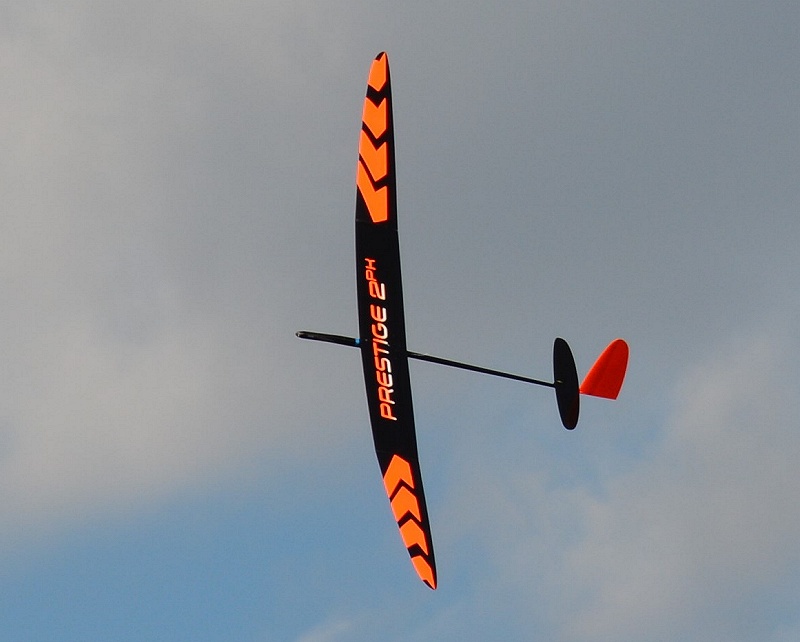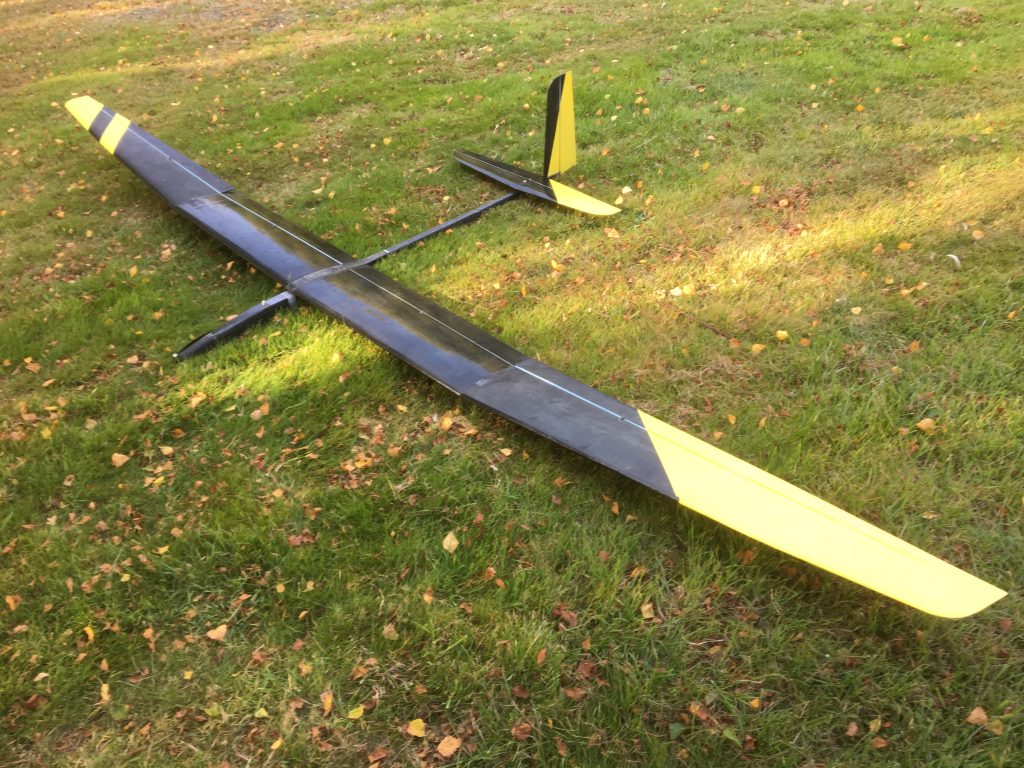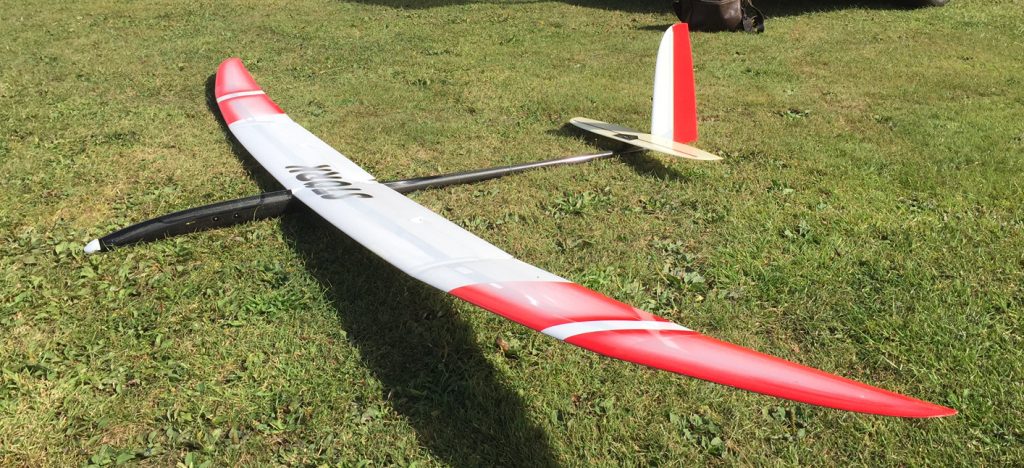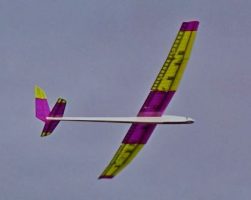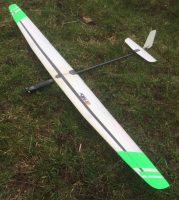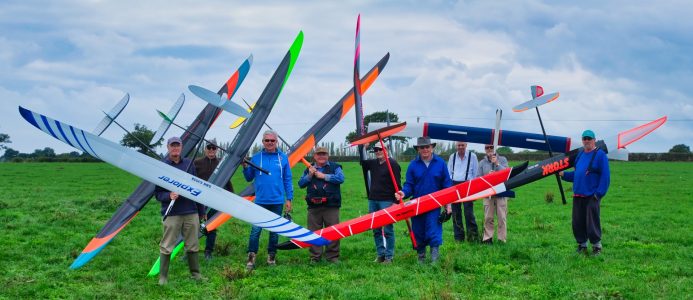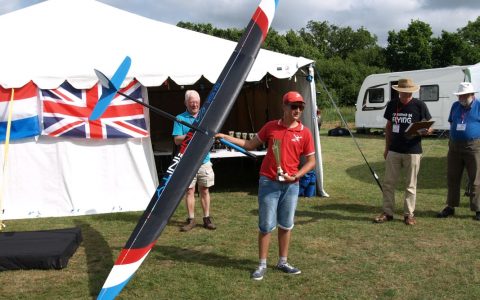These are competitions for gliders fitted with an electric motor and usually an AMRT (Altimeter Motor Run Timer). The motor is used just for launch then switched off for the rest of the flight. The AMRT measures launch height and length of motor run and can cut the motor. The object is usually to fly for as long as possible without going over ten minutes and to land as close as possible to the pilot’s designated spot.
The models
The best electric thermal duration models are glorious 3.5-4m carbon-fibre creations with hollow-moulded or rohacell-cored wings. Models typically weigh 1500gms or less ready to fly and are equipped with six digital servos and geared in-runner motor. The latest top models (as of June 2020) can cost £1500 or more just for the model & about £400 to fit out with servos, motor, speed controller and receiver. And there are plenty of these exotica around. Most top fliers are prepared to pay for the very best, as are many other regular competitors who value the performance edge (and just the bling – these are beautiful models to own).
Don’t let these prices put you off. Clearly not everyone (including some of the best pilots) is willing or able to pay this kind of money and there are plenty of good alternatives: budget moulded models and gear can be many hundreds of pounds cheaper, as can buying second-hand. Built-up model kits are available from a couple of hundred pounds. Some keen builders design and build their own own foam-veneer or built-up models; which requires hours of labour but not a lot of money.
And it is well worth considering a 2m model. These are much cheaper and many competitions have a separate 2m class. Even where this is not the case, well-flown 2m models often beat pilots with the best 4m machines. Or just have a go with your beginner’s foamie – you’ll be made very welcome.
The competition classes
F5J
Most electric thermal duration competitions today are flown to F5J rules. F5J is the class used for World and European team championships, Eurotour competitions, most national competitions and – increasingly – regional and local competitions too. In most other electric duration classes, the AMRT cuts the motor at a set launch height. The distinctive feature of F5J is that the pilot decides each flight when to cut the motor manually and there are extra points for launching low.
F5J rules – outline
- Object: fly 10 mins / land within 1m of the spot, within a 10min slot
- Max motor run 30 secs. (You can restart to save a plane in trouble, but zero score for the flight.)
- No re-launches
- Points awarded:
- Flight time: 1 point per second flight time
- Landing bonus: max 50 points (0-1m from the spot), reducing in 5 points/m increments to 5 points (9-10m from the spot)
- Points deducted:
- 0.5 points per metre launch height up to 200m, 3 points per metre launch height over 200m
- No landing bonus if landing is not within the 10 min slot
- Zero score:
- Motor restart
- Land >75m from the spot
F5J rules – full detail
Not for the faint-hearted …
- FAI F5J rules – download ‘Sporting Code – Section 4: Aeromodelling’ (zipped file). ‘Volume 5 Radio Controlled Electric Powered Motor Gliders’ contains F5J and other classes.
- UK variations – download Rul20-SF.pdf ‘BMFA Contest Rules Section 7’ and go to Section 7.21.
F5J for beginners?
F5J used to be seen as an élite class for top pilots and top-dollar models only (and you may still hear that view). But the advantages of using a single class for all electric thermal duration competitions are increasingly recognised. So, for example, BARCS (British Association of Radio Control Soarers – BMFA Specialist Body) no longer promotes its ELG (Electric Launch Glider) class and favours F5J as a beginners’ as well as an experts’ class. Local competitions, for example in Essex and Kent, have also adopted F5J rules. And recent changes in F5J rules have made the class much more beginner-friendly: it is now possible to restart the motor to retrieve a model which would otherwise land outside the field (you lose the score for that flight but you save the model); and pilots have to fly straight upwind for at least three seconds after launch (removing most of the worries about all models starting at the same time). The extra points for low launches produce fascinating tactical dilemmas for top pilots and (especially in continental european weather conditions) and sometimes hair-raising low-level flying. But that is nothing to do with the beginner in England, where the usual pattern is just to launch to about 150-190m and concentrate on trying to stay in the air for ten minutes and land somewhere near your spot. Any pilot new to competition flying will find themselves warmly welcomed and well supported at any F5J comp.
Other competition classes
The increasing focus on F5J stops pilots getting confused about rule variations and promotes a big national league but other classes are available if you want to try them too.
eSoaring
One other competition class is still flown at a number of venues and recognised by the BMFA: eSoaring. This avoids mass launches by using an 11 minute slot in which to fly ten minutes, allows one re-launch and treats over-flying the ten minutes more generously than in F5J. And it always operates a separate 2m class.
- eSoaring rules can be downloaded from the BMFA Rule Books site (The relevant download is Rul20-SF.pdf and you want Para 7.22)
- Key online spot: eSoaring forum
F5K
Currently in its infancy but likely to become a popular and affordable class: 1.5m models with an electric motor fitted into F3K (hand-launch) designs. One to keep an eye on.
Local
Many clubs often have competitions to their own rules (which may encourage beginners and occasional competitors by excluding expensive moulded models / not requiring an AMRT).
Find out more / have a go
- Video above is from Eamon Keating’s channel
- See also Julian Benz’s videos mainly F5J models – not always flown in ways less expert pilots should try themselves.
Electric Thermal Duration and the SFTC
F5J is an official FAI class and has a BMFA League. The SFTC has responsibilities for recommendation of the national team and team manager and for the league. It is also involved in running the Silent Flight Nationals (at which F5J and other thermal duration classes are flown) and some team trial events. The SFTC works closely with the British Association of Radio Control Soarers (BARCS), the BMFA Specialist Body, which also runs F5J events. A BARCS representative sits on the SFTC and other BARCS Committee members are also elected SFTC members; the two bodies work closely together. The SFTC also has a general responsibility to keep under review safety requirements and environmental effects of all types of model gliders.
Jon Edison (SFTC Chair)

